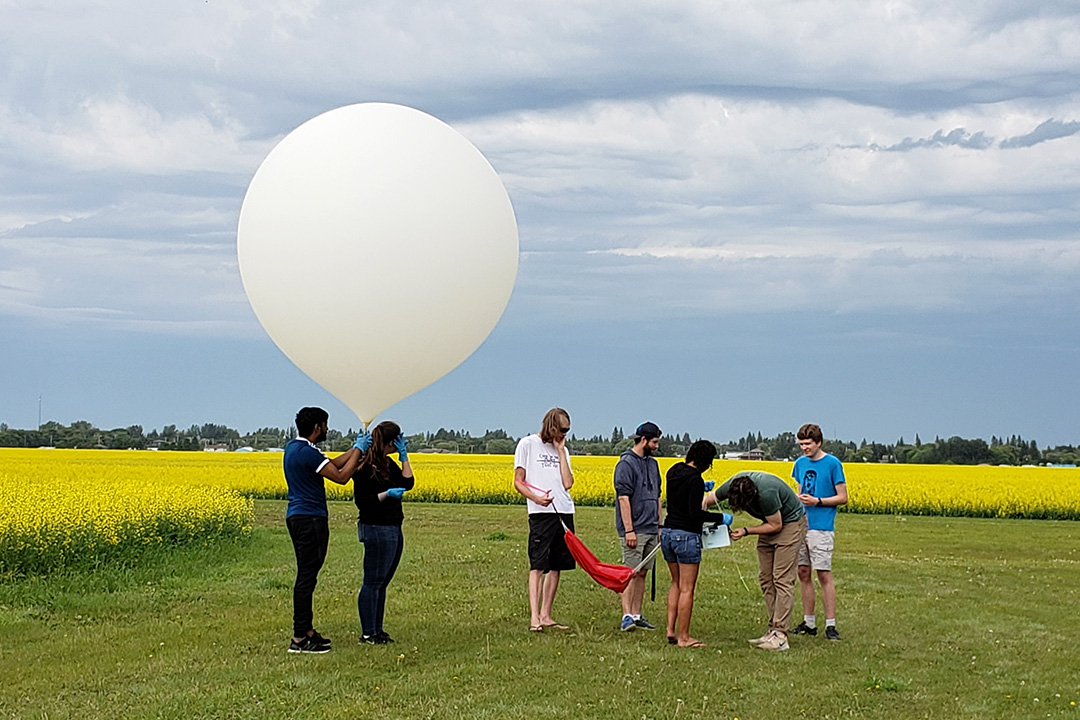
USask students launch balloon simulating space mission to study cosmic rays
University of Saskatchewan students are part of an international team that has launched a balloon 30 kilometres into near-space as the culmination of a special training program that will help them become the next generation of space technology and engineering experts.
By Federica Giannelli, USask Research Profile and ImpactThe launch took place on July 24 at the Cudworth Airport outside of Saskatoon where the team released a balloon, the length of a long pickup truck, carrying equipment similar to that used in cube satellites—mini devices for space research.
The goal of the mission is to measure cosmic rays, particles that come from outside the solar system, and understand how they interact with Earth’s atmosphere.
“A better understanding of cosmic rays is helpful to foresee how these particles may affect satellite communications,” said USask physics PhD student Kimberlee Dube.
The radiation of cosmic rays may also affect astronauts’ DNA causing cancer because, unlike on Earth, there is no “shield” from air particles, so studying cosmic rays can lead to building better protection materials for astronauts.
“Astronauts will be going back to the Moon, and possibly to Mars in our lifetimes. There are many questions that we need to answer, such as how we can support life in space, grow food, and deal with the effects of radiation and microgravity,” said Dr. Laureline Sangalli (PhD), NSERC CREATE International Space Mission (ISM) Training Program instructor and space science professor at the Royal Military College of Canada. “The ISM training program prepares students with the tools to possibly answer those questions.”
After completing an online course, the eight students underwent a three-week hands-on training at USask where they were in charge of designing a space mission, testing the software and the instruments to be sent with the balloon, and analyzing the data. This is the first time the training has been offered in Saskatoon.
The student training program, which started just three years ago, has proven so successful that two previous participants now have landed jobs—one in a Norwegian communications company and the other an internship with the Canadian Space Agency. Another student has started his own company in the industry.
The ISM program teaches students technical skills applicable in industry and academia, and how to work together as a team with people from different educational backgrounds and nationalities.
“This is typical in the space industry where countries share resources to do experiments and study space,” said Dr. Kathryn McWilliams (PhD), USask physics and engineering physics professor and ISM principal investigator.
“Through a simulation of a space mission in a real-life setting, this course prepares students to be high-skilled professionals in the space industry.”
The students drew from their areas of expertise to ensure the space mission would be successful. For example, Connor Schentag, USask engineering physics master’s student, improved the sensors used for measuring cosmic rays from last year’s ISM training and the software used by the sensors to communicate with each other.
“I have always wanted to be an astronaut, but I am too tall, so I have taken this training program because working in the space industry would be the next best thing,” said Matthew Bowen, space physics master’s student at the Royal Military College. He noted that astronauts have to be less than six feet tall to fit in the modules and be sent into space.
Bowen, Dube and Schentag have been working on the project with USask master’s students Syd Ullrich, and Ian McConkey, and Royal Military College master’s space physics student Heather Taylor, as well as Kassi Klepper and Pavithiran Sivasothy, space physics master’s students at University of Tromsø, Norway.
The training program, funded by USask and the federal granting agency NSERC, builds on a long-standing partnership between Canada and Norway which both, as Arctic countries, focus on improving space technology and ground infrastructure vulnerable to space weather effects.
The ISM training program was developed by USask with Royal Military College, University of Alberta and University of Calgary, as well as several universities in Norway.
Read more about space research at Usask.

